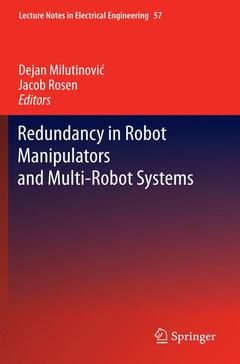Description
Redundancy in Robot Manipulators and Multi-Robot Systems, 2013
Lecture Notes in Electrical Engineering Series, Vol. 57
Coordinators: Milutinović Dejan, Rosen Jacob
Language: English
Publication date: 11-2014
244 p. · 15.5x23.5 cm · Paperback
Publication date: 10-2012
244 p. · 15.5x23.5 cm · Hardback
Description
/li>Contents
/li>Comment
/li>
The trend in the evolution of robotic systems is that the number of degrees of freedom increases. This is visible both in robot manipulator design and in the shift of focus from single to multi-robot systems. Following the principles of evolution in nature, one may infer that adding degrees of freedom to robot systems design is beneficial. However, since nature did not select snake-like bodies for all creatures, it is reasonable to expect the presence of a certain selection pressure on the number of degrees of freedom. Thus, understanding costs and benefits of multiple degrees of freedom, especially those that create redundancy, is a fundamental problem in the field of robotics.
This volume is mostly based on the works presented at the workshop on Redundancy in Robot Manipulators and Multi-Robot Systems at the IEEE/RSJ International Conference on Intelligent Robots and Systems - IROS 2011. The workshop was envisioned as a dialog between researchers from two separate, but obviously related fields of robotics: one that deals with systems having multiple degrees of freedom, including redundant robot manipulators, and the other that deals with multirobot systems. The volume consists of twelve chapters, each representing one of the two fields.
Presents the most recent work on the design of redundant robot systems, their control, performance, human-robot interaction and reliability analysis
Based on contributions presented at the IROS 2011 Workshop on Redundancy in Robot Manipulators and Multi-Robot Systems, held in Septemebr 2011, San Francisco
Written by leading experts in the field
These books may interest you

Robot Force Control 158.24 €



